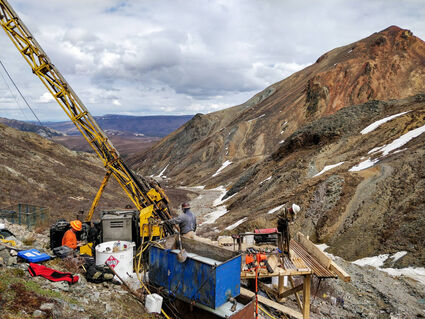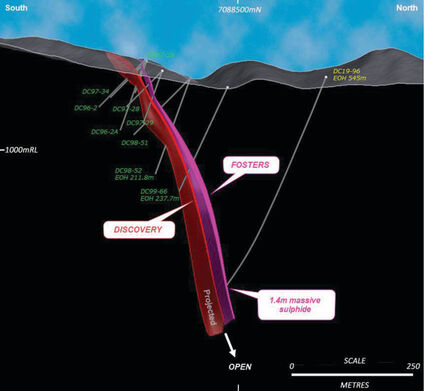Drill discovers major Dry Creek extension
North of 60 Mining News – November 1, 2019
Last updated 9/26/2020 at 11:08am

White Rock Minerals Ltd.
Drills tap zinc mineralization 200 meters below the deepest previous hole at the Dry Creek deposit on White Rock Minerals' Red Mountain project in Alaska.
White Rock Minerals Ltd. Oct. 29 said the last hole of its 2019 drill program at Red Mountain indicates the potential for significant resource expansion at this zinc-rich volcanogenic massive sulfide project in Interior Alaska.
Two VMS deposits on the Red Mountain property – Dry Creek and West Tundra Flats (WTF) – host 9.1 million metric tons of Australian Joint Ore Reserves Committee- (JORC) compliant inferred resources averaging 5.8 percent (1.17 billion pounds) zinc; 2.6 percent (516 million lb) lead; 0.1 percent (26.5 million lb) copper; 157 grams per metric ton (46.1 million ounces) silver; and 0.9 g/t (260,000 oz) gold.
The Dry Creek deposit hosts roughly 25 percent of this resource in two parallel lenses – Foster and Discovery. Drilling, however, indicates that this deposit could be much larger.
The last hole drilled this year, DC19-96, cut 1.4 meters of massive sulfide mineralization with abundant sphalerite (zinc mineral) more than 200 meters down-dip from the Fosters and Discovery lenses, which host the bulk of the Dry Creek resources. This would more than double the depth of the mineralization in this area of Dry Creek.
The zinc mineralization tapped in DC19-96 is within stratigraphy equivalent to the Fosters lens. Poor ground conditions and winter weather prevented drilling to continue to the stratigraphy where the Discovery lens is expected. This hole, however, did intersect a chert horizon that correlates with the lower Discovery, which indicates the bit was nearing this parallel lens of massive sulfide mineralization when the hole was terminated.
Assays from DC19-96 are pending.
Other holes drilled since the Dry Creek resource was calculated indicate the potential for expansion of the Foster and Discovery lenses.
DC18-77, which encountered the Foster lens during the 2018 drill season, cut 4.26 meters averaging 4.8 percent zinc, 2.3 percent lead, 1,435 g/t (46.1 oz/t) silver, 2.2 g/t gold and 0.5 percent copper – the equivalent of 43.2 percent zinc when accounting for the value of all the metals. This was part of a 9.39-meter intercept that averaged 2.6 percent zinc, 1.3 percent lead, 686 g/t silver, 1.1 g/t gold and 0.3 percent copper, or 21.1 percent zinc-equivalent.
Another 2018 hole, DC18-79, cut 4.72 meters averaging 19.5 percent zinc, 7.8 percent lead, 466 g/t silver, 6.9 g/t gold and 1.5 percent copper, or 49.7 percent zinc-equivalent in the Discovery lens. This was part of a 16-meter intercept averaging 6.4 percent zinc, 2.6 percent lead, 152 g/t silver, 2.2 g/t gold and 0.5 percent copper, or 16.1 percent zinc-equivalent.
The high-grade mineralization tapped in both holes was down-dip of the Dry Creek resource.
The high grades tapped below Dry Creek last year and the substantial down-dip extensions encountered in DC19-96 provide White Rock Minerals with a tantalizing resource expansion target at Dry Creek when it returns to Red Mountain in 2020.
–SHANE LASLEY












Reader Comments(0)